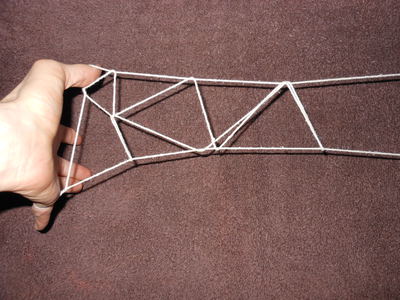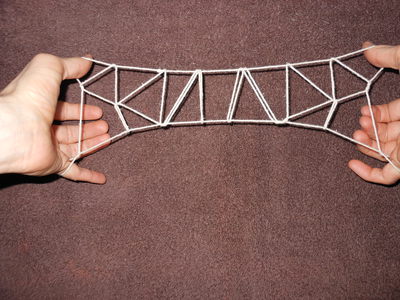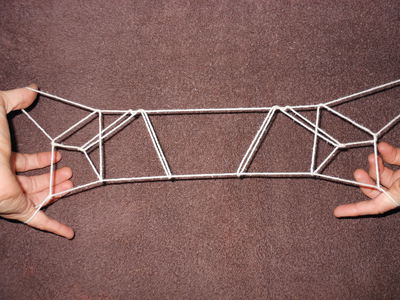
LLX > Neil Parker > String Figures > Odds & Ends

This figure, widely known to the Inuit, actually represents a legendary creature called kilivfaq. Stories describe it as a large animal, with either six, eight, or ten legs, and a short tail, and (in some stories) a human face. Being large and strong, it is dangerous to hunt, but apparently well worth the risk, because as long as the bones are not scraped completely clean, the meat regrows on it, and can be harvested again, up to three times.
Stories about kilivfaq are told as far east as Greenland, but the origin of the legend is in Alaska and the Yukon, where the frozen remains of woolly mammoths and mastodons are occasionally found. These remains are apparently the source of the legend.
1. Position 1.
2. Pass right index from above behind left palmar string, and hook it back to the right. Keep it clasped to the right palm.
3. Insert left index from below into left little finger loop. Turning the index away from you and down, hook it over left far little finger string, and then turn it a half-turn toward you and up.
4. Turn left index toward you and down in front of left near thumb string, and then away from you and up, picking up left near thumb string, and allowing original left index loop to slip off.
5. Turn left thumb away from you and down (thus untwisting left thumb loop). Then pass it away from you, and pick up left near little finger string (to the right of the place where the left far little finger string crosses in front of it). Return carrying near little finger string back through original thumb loop (which slips off).
6. Insert left thumb into left index loop from above, and hook down left near index string, letting original left thumb loop slip off.
7. Pass left thumb away under all strings, and then back toward you into left little finger loop from above. Pick up left near little finger string with palm of left thumb, and turn left thumb to the right and toward you, letting original left thumb loop slip off. Continue turning the left thumb toward you, down, away from you, up, and back toward you, picking up the former left near thumb string (which slipped off earlier in this step), and pulling it back through thumb loop (which slips off).
8. Release both index loops.
9. Untwist the figure by twisting the right hand loop a full twist toward you.

1. Opening A, using middle fingers in place of indexes.
2. Do steps 3 through 7 of Mammoth (above), doing all movements with both hands rather than just the left hand. Whenever you need to go past middle finger loops, go under them.
3. Release index and middle finger loops.
Some manual rearrangement of the strings is usually necessary to separate the two mammoths from each other.
These instructions are from [Paterson 1949] (figure 41a, "Kilivfaq," and 41b, "Kilifräitˢiq"). [Jenness 1924] has the same instructions for Mammoth (figure XXXIII, "Spirit of the Lake"), but his instructions for Two Mammoths ("Two Spirits of the Lake") start with the middle fingers pointing down rather than up, which makes the figure much clumsier and harder to do.
[Mary-Rousselière 1969] has somewhat different methods for both figures (figure 37, "KILIGVAGJUK - Le mammouth," and figure 37bis, "KILIGVAGJÛK IGLUGÊK - Les deux mammouths"). He also has a third figure, Two Mammoths with Their Young (figure 38, "KILIGVARÂRÎT - Les deux mammouths avec leurs petits"), made by making Two Mammoths, untwisting the little finger loops, and then making Two Mammoths again, as if the completed figure were Position 1...unfortunately, the resulting figure comes out too tangled to be effectively presented.

The reader who has studied my collection of Jayne's finished-pattern-only figures may have noted the strong similarity between the Mammoth above and Gordon's Lake Fish, which differ only in a single step. This raises the question: Can one Lake Fish be turned into two, the same way one Mammoth can?
The answer turns out to be yes. The figure isn't documented anywhere, but the steps are so similar to Two Mammoths that I hesitate to call this my own invention.
1. Opening A, using middle fingers in place of indexes.
2. Do steps 3 through 7 of Lake Fish, doing all movements with both hands rather than just the left hand. Whenever you need to go past middle finger loops, go under them.
3. Release index and middle finger loops.
Some manual rearrangement of the strings is usually necessary to separate the two fish from each other.
The same procedure can be used to turn [Jenness 1924]'s figure XXIV ("Fish Nibbling at a Hook") into Two Fish Nibbling at Hooks. The reverse procedure can be used to turn his figure LVII ("Two Fawns") into one Fawn. Both modified figures are in [Mary-Rousselière 1969] (figure 3bis, "NUKATUGACIÂK IGLULÊK - Les deux jeunes caribous," i.e., The Two Young Caribou, and figure 4, "NOQACIAQ - Le faon de caribou," i.e., The Caribou Fawn), but Two Lake Fish is not.
[Mary-Rousselière 1969]'s method for making the Mammoth is probably worth describing:
1. Opening A (made the normal way, with indexes).
2. Pass left middle finger down between left far thumb string and left near index string, and away from you, and up into left little finger loop from below. Hook it over left far little finger string, and carry this string back toward you and up between thumb and index loops. Keep left middle finger pointing down.
3. Insert left index downward into left middle finger loop, beside middle finger. Move left index toward you, carrying left near index-middle-finger string, over left thumb loop, and down on near side of left near thumb string. Insert left middle finger from above into left thumb loop, and pinch left near thumb string between index and middle finger.
4. With a half-twist away from you and up, pick up left near thumb string on left index and draw it up through left index-middle-finger loop (which slips off).
5. Continue with step 5 of Mammoth as described above (ignoring the lower left index loop - when index strings are mentioned, they belong to the upper loop). When you reach step 8, release all index loops and right little finger loop.
This tends to produce a slightly smaller Mammoth than the Paterson/Jenness method.